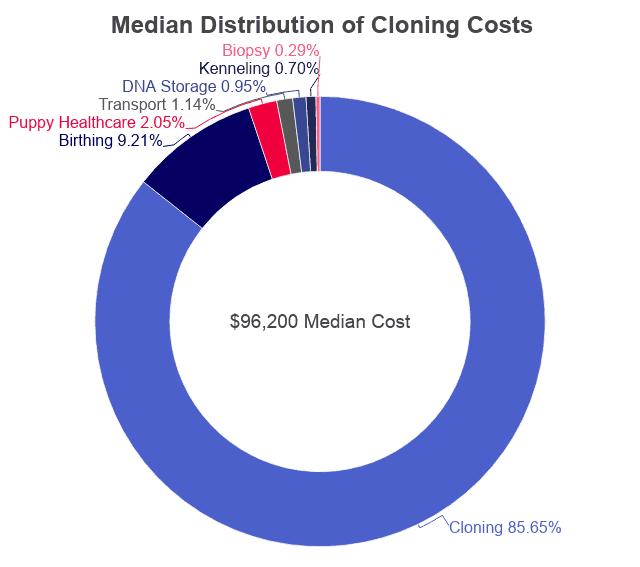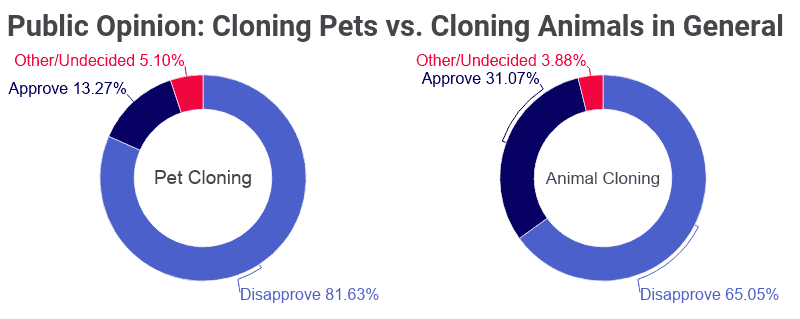Report Highlights. The low-end total cost to clone a pet is $26,140. While cloning has its limitations, data trends indicate pet cloning could become a significant market in the pet industry.
- $37,500 is the average cost to have a pet cloned.
- The most expensive pet cloning services cost over $150,000.
- Pet cloning costs less than half of what it did 12 years ago.
- It can take as little as 6 months to clone a pet.
Cloning Cost Breakdown
| Item | Low End Cost | High End Cost |
| Biopsy | $60 | $450 |
| Cold Storage | $100 | $1600 |
| Cloning* | $25,000 | $150,000 |
| Birth and Weaning | $300 | $7,900 |
| Kenneling | $250 | $1,000 |
| Travel and Transport | $30 | $2,000+ |
| Puppy Healthcare | $400 | $3,250 |
| Total | $26,140 | $166,200+ |
*This includes fusing the donor DNA with an unfertilized egg, as well as the embryonic implantation into the surrogate mother.
Pet Cloning Costs
The price of cloning a pet has decreased significantly since the process became commercially available in 2004. In addition to delicate scientific processes, living donors and surrogates require care.
- $50,000 is the current average cost of cloning one dog.
- $25,000 is the average cost of cloning a cat.
- $195 is the median cost of a biopsy or initial cell harvest.
- $650 is the median price for cold storage of a pet’s harvested cells or DNA banking.
- $100,000 was the minimum cost of cloning an animal in 2008 ($122,750 in 2020 dollars).
- Adjusting for inflation, that’s a 60% price drop for dogs, and an 80% price drop for cats.
- For $150,000, companies will use multiple immature, denucleated egg cells to guarantee a viable embryo.
- $96,200 is the median cost between low- and high-end prices.

Pet Cloning Statistics
Though Dolly the sheep’s clone made headlines in 1997, commercial pet cloning was not available until the early 21st century. Prices dropping in recent years implies such services may become more commonplace.
- It takes an average of 8 months total for a pet to be cloned.
- The embryonic implantation, gestation, and birthing process takes 6 months.
- The cloned animal must be 2 months old before leaving their surrogate mother.
- In 1997, a billionaire in Arizona made the earliest known attempt to artificially clone a pet.
- He privately funded $3.7 million worth of research at Texas A&M University in order to clone his dog, Missy.
- 245 dogs and cats took part in the project (called “Missyplicity”) experiments, all of which failed.
- The first cloned dog, an Afghan hound named Snuppy, would not be born until 2005.
- In 2015, Snuppy himself was cloned, which ultimately produced three surviving “reclones.”

Animal Cloning Statistics
Though cloning living organisms is a new process, it already has an extensive history, much of which remains unknown to the public. Scientists are generally tight-lipped about failed experiments for fear of losing funding, so details about the earliest attempts at artificial cloning are sparse.
- Clones occur naturally among bacteria and other organisms that reproduce asexually.
- 1952 may be the year the world’s first artificially cloned animal – a frog – was born; the validity of this claim is unconfirmed.
- In 1984, a British researcher claimed to have cloned the first mammal; it remains unconfirmed whether the lamb he produced was created via nuclear transfer.
- In 1996, scientists used DNA from an adult sheep clone, a lamb they called Dolly (her existence was not revealed to the world until the following year).
- Since Dolly, hundreds – if not thousands – of animals have been cloned for commercial purposes as well as for research.
- In 2008, the U.S. Food and Drug Administration (FDA) declared meat and milk from cloned animals to be safe for human consumption.
- Americans are 57.3% less likely to approve of pet cloning than they are of animal cloning in general.
- 82% of people said they disapproved of cloning pets.
- 65% said they disapproved of cloning animals in general.
Common Reasons for Cloning a Pet
| Duplicate Tissues | Animals get sick just like people do. In some cases, a beloved pet may need an organ or a tissue transplant in order to survive. A genetic copy would increase the likelihood of a successful transplant. |
| Sentiment | Owners and trainers develop powerful bonds with their animals. When the animal is gone and that bond is lost, it can be emotionally devastating. A clone provides a genetic copy of the lost animal that may be receptive to behavioral conditioning. |
| Desirable Traits | Breeders already pair animals with the hope their offspring will carry their parents’ more desirable traits. Cloning eliminates the guesswork involves by providing a genetic replica. |
| Commerce | Famous dogs, such as Lassie and Rin-Tin-Tin, often create an increased demand for their breeds. Superfans might be willing to pay for a genetic copy of their favorite famous animal. |
Successfully Cloned Species
Some animals have more complicated reproductive systems. Not every species has been cloned with success, and even some of those that have would not be considered candidates for commercial cloning due to the difficulty or low success rate.
|
|
|
Notable Animal Clones
Most people don’t learn about scientific breakthroughs until the news reaches mass media, so the general public’s knowledge of pet cloning mainly comes from stories of famous animals or celebrities who have cloned their pets.
- CC was the world’s first cloned cat, produced in 2002 by Genetic Savings and Clone in partnership with Texas A&M University-College Station. A living example of genetic cloning’s limitations, she looked nothing like her “original.” Rainbow was an orange calico, but in the cells used to make CC, the recessive orange genes were inactive; as a result, genetic copy CC was a brindled gray.
- Chase was a golden Labrador Retriever and one of the South Korean customs’ all-time best sniffer dogs. All 7 of Chase’s clones, born in 2007 at Seoul National University (SNU), have successfully passed the specialized training for which dogs selectively bred for the job only have a 30% success rate.
- Tegon and Ruby Puppy were also cloned at SNU in 2009 and 2016, respectively. Both dogs glow in the dark using the addition of enhanced fluorescent proteins injected into eggs prior to fertilization. Tegon, a beagle, glows green while Ruby glows red.
- Trakr was a German Shepherd trained as a sniffer dog with a Canadian K9 unit. He gained fame as the highly-decorated search and rescue dog who discovered the last surviving victim in the rubble of the World Trade Center in New York City after the airborne attacks of September 11, 2001. He was cloned by BioArts International in 2009.
- Samantha was a Coton de Tulear that made international news, featuring in the New York Times and National Geographic, when owner Barbara Streisand revealed she’d had Samantha cloned in 2018.
- Garlic had already been buried for hours when his owner, Huang Yu, remembered reading an article about cloning dogs. After digging up his beloved cat, Huang stored Garlic’s body in his refrigerator. Not only did Garlic become the first cat cloned in China, his clone is rare for having come from cells of a deceased animal. (Cells begin to break down immediately upon death. Because cloning requires fully-intact DNA, it’s best to take samples while the source organism is still alive.)
Criticism of the Pet Cloning Industry
Considering how much Americans love their pets, it would be natural to expect people to be intrigued by the idea of having a pet cloned. Just 13% of Americans, however, say they approve of commercial pet cloning.
- Critics have a list of complaints about commercial cloning and its industry, including the emotional and psychological costs of cloning pets.
- Detractors argue that cloning companies misrepresent their product, that any individual being is the sum of their experiences and cannot be replicated simply via genetic cloning.
- Further, critics accuse companies of preying on grief with false promises, asserting that the idea that a beloved animal could be returned to them may make a desperate pet owner blind to the limitations of cloning.
- Finally, there is no guarantee that the cloned animal will have the desired physical characteristics of its genetic donor. As CC the cat demonstrated, geneticists can’t always predict exactly which genes will present in the clone.
Sources:
- Cloned Dogs Training for Search and Rescue
- My Friend Again – The Dog Cloning Company, Cat & Dog Cloning Cost
- Barbara Streisand Explains: Why I Cloned My Dog
- Scientists Genetically Engineer Glowing Dog
- As the Cost of Dog Cloning Drops, Here’s Which Breeds Lead the Pack
- North Carolina State University: Human Cloning
- Genetic Savings and Clone: No Pet Project
- His Cat’s Death Left Him Heartbroken. So He Cloned It.
- Kansas State University Biopsy Price Calculator
- Illinois State University
- Consumer Price Index Inflation Calculator
- How Much Does it Cost to Be a Dog Breeder?
- National Human Genome Research Institute: Cloning Fact Sheet
- CNN: Cloning Fast Facts
- Animal Cloning: A Risk Assessment
- Frequently Asked Questions About Animal Cloning
- Genetics and Society Animal and Pet Cloning Opinion Polls
- Wikipedia: Dog Breeding
- American Anti Vivisection Society’s Report on Pet Cloning: Separating the Facts from the Fluff
- Birth of Clones of the World’s First Cloned Dog
